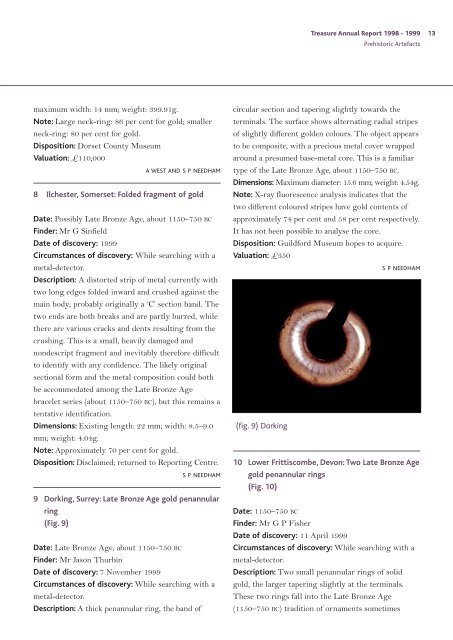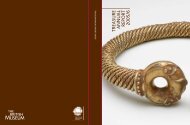Treasure Annual Report 1998-1999 - Portable Antiquities Scheme
Treasure Annual Report 1998-1999 - Portable Antiquities Scheme
Treasure Annual Report 1998-1999 - Portable Antiquities Scheme
Create successful ePaper yourself
Turn your PDF publications into a flip-book with our unique Google optimized e-Paper software.
maximum width: 14 mm; weight: 399.91g.<br />
Note: Large neck-ring: 86 per cent for gold; smaller<br />
neck-ring: 80 per cent for gold.<br />
Disposition: Dorset County Museum<br />
Valuation: £110,000<br />
A WEST AND S P NEEDHAM<br />
8 Ilchester, Somerset: Folded fragment of gold<br />
Date: Possibly Late Bronze Age, about 1150–750 BC<br />
Finder: Mr G Sinfield<br />
Date of discovery: <strong>1999</strong><br />
Circumstances of discovery: While searching with a<br />
metal-detector.<br />
Description: A distorted strip of metal currently with<br />
two long edges folded inward and crushed against the<br />
main body; probably originally a ‘C’ section band. The<br />
two ends are both breaks and are partly burred, while<br />
there are various cracks and dents resulting from the<br />
crushing. This is a small, heavily damaged and<br />
nondescript fragment and inevitably therefore difficult<br />
to identify with any confidence. The likely original<br />
sectional form and the metal composition could both<br />
be accommodated among the Late Bronze Age<br />
bracelet series (about 1150–750 BC), but this remains a<br />
tentative identification.<br />
Dimensions: Existing length: 22 mm; width: 8.5–9.0<br />
mm; weight: 4.04g.<br />
Note: Approximately 70 per cent for gold.<br />
Disposition: Disclaimed; returned to <strong>Report</strong>ing Centre.<br />
S P NEEDHAM<br />
9 Dorking, Surrey: Late Bronze Age gold penannular<br />
ring<br />
(Fig. 9)<br />
Date: Late Bronze Age, about 1150–750 BC<br />
Finder: Mr Jason Thurbin<br />
Date of discovery: 7 November <strong>1999</strong><br />
Circumstances of discovery: While searching with a<br />
metal-detector.<br />
Description: A thick penannular ring, the band of<br />
<strong>Treasure</strong> <strong>Annual</strong> <strong>Report</strong> <strong>1998</strong> - <strong>1999</strong> 13<br />
Prehistoric Artefacts<br />
circular section and tapering slightly towards the<br />
terminals. The surface shows alternating radial stripes<br />
of slightly different golden colours. The object appears<br />
to be composite, with a precious metal cover wrapped<br />
around a presumed base-metal core. This is a familiar<br />
type of the Late Bronze Age, about 1150–750 BC.<br />
Dimensions: Maximum diameter: 15.6 mm; weight: 4.54g.<br />
Note: X-ray fluorescence analysis indicates that the<br />
two different coloured stripes have gold contents of<br />
approximately 74 per cent and 58 per cent respectively.<br />
It has not been possible to analyse the core.<br />
Disposition: Guildford Museum hopes to acquire.<br />
Valuation: £350<br />
(fig. 9) Dorking<br />
S P NEEDHAM<br />
10 Lower Frittiscombe, Devon: Two Late Bronze Age<br />
gold penannular rings<br />
(Fig. 10)<br />
Date: 1150–750 BC<br />
Finder: Mr G P Fisher<br />
Date of discovery: 11 April <strong>1999</strong><br />
Circumstances of discovery: While searching with a<br />
metal-detector.<br />
Description: Two small penannular rings of solid<br />
gold, the larger tapering slightly at the terminals.<br />
These two rings fall into the Late Bronze Age<br />
(1150–750 BC) tradition of ornaments sometimes





